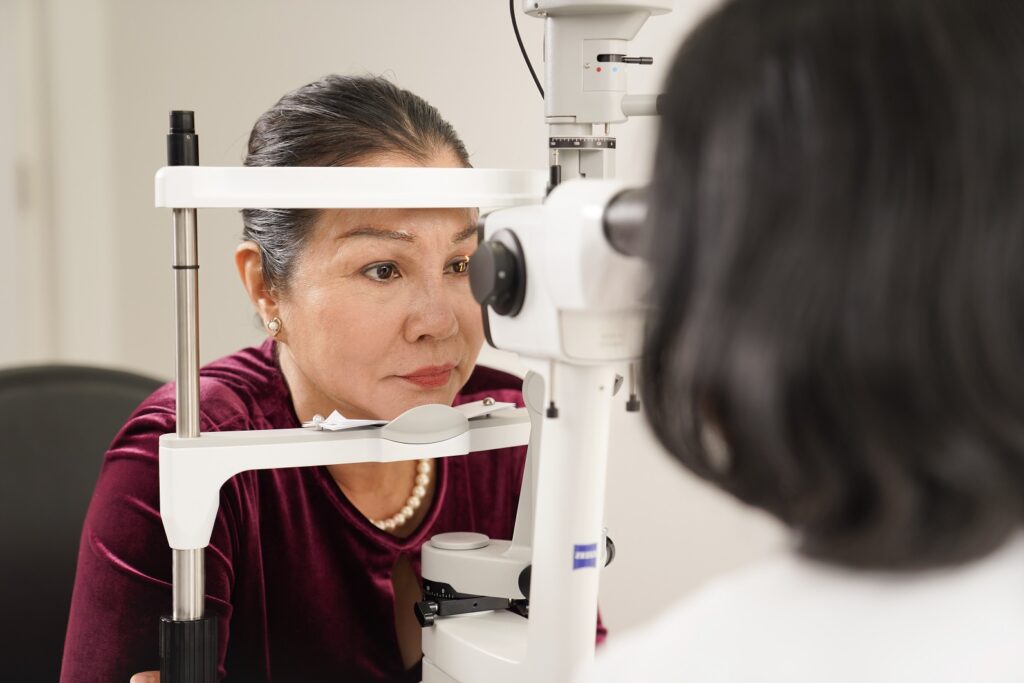
Retina, Prima Medical Center Saigon, Diabetic
Diabetic retinopathy: Signs, Symptoms and Solutions
12 October, 2023
Prima Saigon: According to statistics, up to 90% of diabetics suffer from eye complications. Among them, diabetic retinopathy is the most dangerous complication. If the patient is not detected and treated in time, it can lead to blindness.

Diabetic retinopathy: Signs, Symptoms and Solutions
1. What is retinopathy?
Diabetic retinopathy is a group of eye diseases caused by complications of diabetes. These complications can cause severe vision loss or even lead to blindness.
Diabetic retinopathy includes:
Diabetic retinopathy – damage to the blood vessels of the retina
- Cataracts – cataracts develop early in people with diabetes
- Glaucoma (glaucoma)
2. How does diabetic retinopathy affect the eyes?
- Diabetic retinopathy – damage to the blood vessels of the retina
- Cataracts – cataracts develop early in people with diabetes
- Glaucoma (glaucoma)
3. How does diabetic retinopathy affect vision?
When a patient has diabetic retinopathy, the blood vessels of the eye will lose vision in two ways:
- Fragile, abnormal blood vessels progress and rupture causing hemorrhage into the center of the eye causing blurred vision, this stage is called proliferative retinopathy.
- Fluid can leak into the center of the macula, causing edema, thereby reducing vision. This condition is called macular edema.
4. Objects
Anyone at risk for type 1 or type 2 diabetic retinopathy is at risk for uncontrolled diabetic retinopathy. Hispanics and African-Americans are at high risk for retinopathy. People with medical conditions such as high blood pressure and high blood cholesterol are also at high risk
- Women who are pregnant and face a high risk of diabetes and diabetic retinopathy.
- Smoker
5. Symptoms
Diabetic retinopathy is preventable, but it causes no symptoms in its early stages and is painless. However, patients should not wait until symptoms appear to prevent, it is best to have a dilated eye exam at least once a year (especially for people with diabetes).
Symptoms of diabetic retinopathy:
- Seeing black dots or flying flies
- Blurred vision
- Seeing dark spots in the center of the eyes
- Hard to see at night
6. Diagnosis & Treatment
Diagnosis
Diabetic retinopathy is usually detected through the following methods:
- Measurement of eyesight
- Dilated eye exam
- Fundus examination or fundus photography
- Fluorescent retinal angiography
- Optical consolidation imaging (OCT)
Patients need to control and maintain stable blood sugar, carefully monitor diabetic retinopathy.
Treatment
There are 3 main treatment methods for diabetic retinopathy: Laser surgery, intraocular corticosteroid injection or Anti-VEGF drug & vitrectomy. These methods are highly effective in reducing the progression of vision loss caused by the disease. However, they cannot completely cure diabetic retinopathy.

Patients must also control blood pressure and blood fats
Some notes:
- Do not smoke and avoid exposure to secondhand smoke
- Control associated hypertension
Duration of diabetes is the greatest risk factor for the development and progression of diabetic retinopathy. To reduce the risk of diabetic complications on the retina, in addition to having good control of blood sugar, patients must also control blood pressure and blood fats. Besides, it is necessary to eliminate other risk factors such as smoking, obesity with appropriate diets, health care, regular exercise and exercise.

Retina Screening @ Prima Saigon
Diabetic retinopathy is a dangerous complication that can lead to blindness. However, by having regular eye exams at reputable ophthalmology hospitals to screen for the disease, detecting the disease at an early stage without symptoms will contribute to preventing severe progression of the disease, to avoid the following cases. unfortunately happened. If you have diabetes, you should have a dilated eye exam to check the condition of your retina at least once a year.
Our Ophthalmology Care Team
- Dr THAO Vo, Chief Medical Officer , Prima Medical Center Saigon
- Dr AN Trinh, Head of General Ophthalmology
- Dr BINH Tran, Senior Consultant
- Dr TRAN Nguyen, Consultant
Prima Saigon is one of the prestigious eye hospitals in Vietnam, recognized by the US embassy in Vietnam.
If you need an eye assessment, please have a visit to Prima Medical Center Saigon
- Address: 27 Ky Dong St, District 3, HCMC
- Website: https://primahealth.vn/en/
- Business Hours: 07:30 – 17:00 from Monday – Saturday
- HOTLINE: 0919-209-039 or 1900 – 9115
Prima Saigon recommends that clients should reserve their intended consultation at least three days before their visit for convenience and less waiting time.
Prima Saigon: According to statistics, up to 90% of diabetics suffer from eye complications. Among them, diabetic retinopathy is the most dangerous complication. If the patient is not detected and treated in time, it can lead to blindness.

Diabetic retinopathy: Signs, Symptoms and Solutions
1. What is retinopathy?
Diabetic retinopathy is a group of eye diseases caused by complications of diabetes. These complications can cause severe vision loss or even lead to blindness.
Diabetic retinopathy includes:
Diabetic retinopathy – damage to the blood vessels of the retina
- Cataracts – cataracts develop early in people with diabetes
- Glaucoma (glaucoma)
2. How does diabetic retinopathy affect the eyes?
- Diabetic retinopathy – damage to the blood vessels of the retina
- Cataracts – cataracts develop early in people with diabetes
- Glaucoma (glaucoma)
3. How does diabetic retinopathy affect vision?
When a patient has diabetic retinopathy, the blood vessels of the eye will lose vision in two ways:
- Fragile, abnormal blood vessels progress and rupture causing hemorrhage into the center of the eye causing blurred vision, this stage is called proliferative retinopathy.
- Fluid can leak into the center of the macula, causing edema, thereby reducing vision. This condition is called macular edema.
4. Objects
Anyone at risk for type 1 or type 2 diabetic retinopathy is at risk for uncontrolled diabetic retinopathy. Hispanics and African-Americans are at high risk for retinopathy. People with medical conditions such as high blood pressure and high blood cholesterol are also at high risk
- Women who are pregnant and face a high risk of diabetes and diabetic retinopathy.
- Smoker
5. Symptoms
Diabetic retinopathy is preventable, but it causes no symptoms in its early stages and is painless. However, patients should not wait until symptoms appear to prevent, it is best to have a dilated eye exam at least once a year (especially for people with diabetes).
Symptoms of diabetic retinopathy:
- Seeing black dots or flying flies
- Blurred vision
- Seeing dark spots in the center of the eyes
- Hard to see at night
6. Diagnosis & Treatment
Diagnosis
Diabetic retinopathy is usually detected through the following methods:
- Measurement of eyesight
- Dilated eye exam
- Fundus examination or fundus photography
- Fluorescent retinal angiography
- Optical consolidation imaging (OCT)
Patients need to control and maintain stable blood sugar, carefully monitor diabetic retinopathy.
Treatment
There are 3 main treatment methods for diabetic retinopathy: Laser surgery, intraocular corticosteroid injection or Anti-VEGF drug & vitrectomy. These methods are highly effective in reducing the progression of vision loss caused by the disease. However, they cannot completely cure diabetic retinopathy.

Patients must also control blood pressure and blood fats
Some notes:
- Do not smoke and avoid exposure to secondhand smoke
- Control associated hypertension
Duration of diabetes is the greatest risk factor for the development and progression of diabetic retinopathy. To reduce the risk of diabetic complications on the retina, in addition to having good control of blood sugar, patients must also control blood pressure and blood fats. Besides, it is necessary to eliminate other risk factors such as smoking, obesity with appropriate diets, health care, regular exercise and exercise.

Retina Screening @ Prima Saigon
Diabetic retinopathy is a dangerous complication that can lead to blindness. However, by having regular eye exams at reputable ophthalmology hospitals to screen for the disease, detecting the disease at an early stage without symptoms will contribute to preventing severe progression of the disease, to avoid the following cases. unfortunately happened. If you have diabetes, you should have a dilated eye exam to check the condition of your retina at least once a year.
Our Ophthalmology Care Team
- Dr THAO Vo, Chief Medical Officer , Prima Medical Center Saigon
- Dr AN Trinh, Head of General Ophthalmology
- Dr BINH Tran, Senior Consultant
- Dr TRAN Nguyen, Consultant
Prima Saigon is one of the prestigious eye hospitals in Vietnam, recognized by the US embassy in Vietnam.
If you need an eye assessment, please have a visit to Prima Medical Center Saigon
- Address: 27 Ky Dong St, District 3, HCMC
- Website: https://primahealth.vn/en/
- Business Hours: 07:30 – 17:00 from Monday – Saturday
- HOTLINE: 0919-209-039 or 1900 – 9115
Prima Saigon recommends that clients should reserve their intended consultation at least three days before their visit for convenience and less waiting time.



